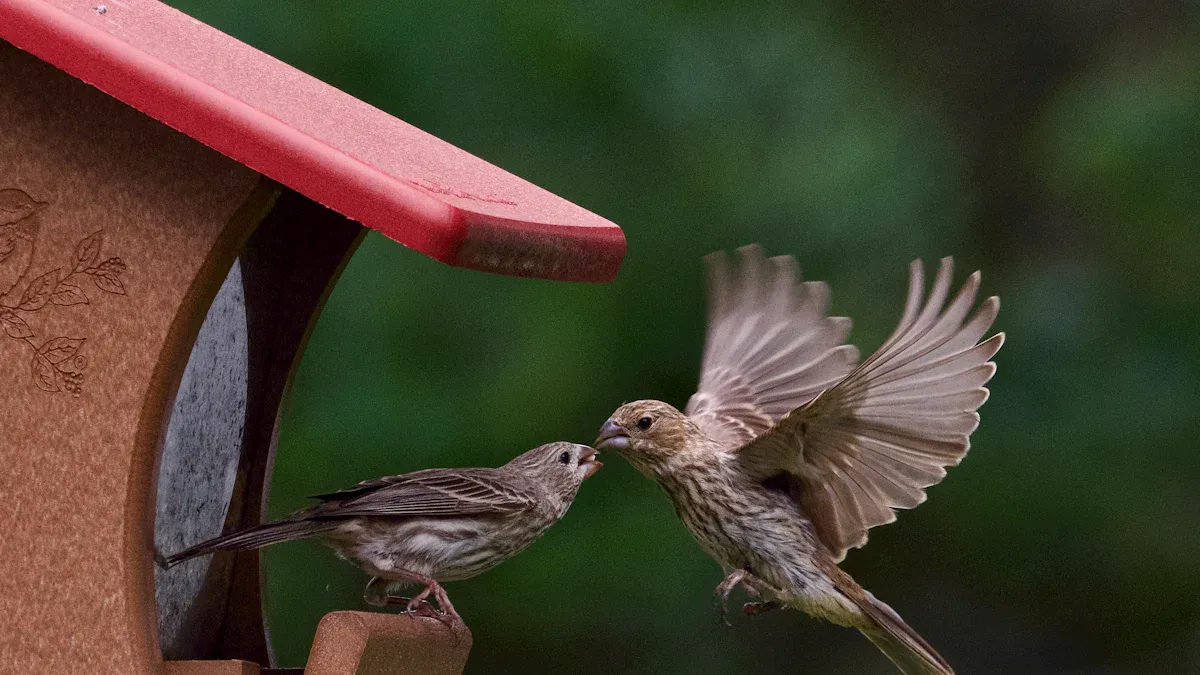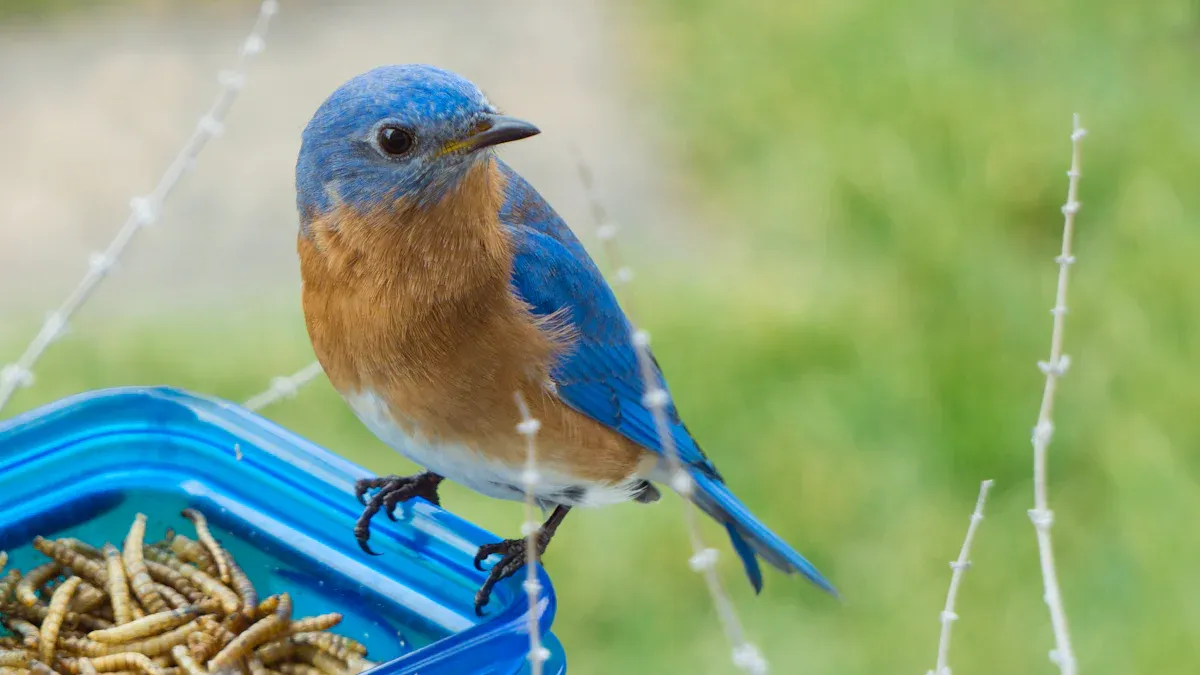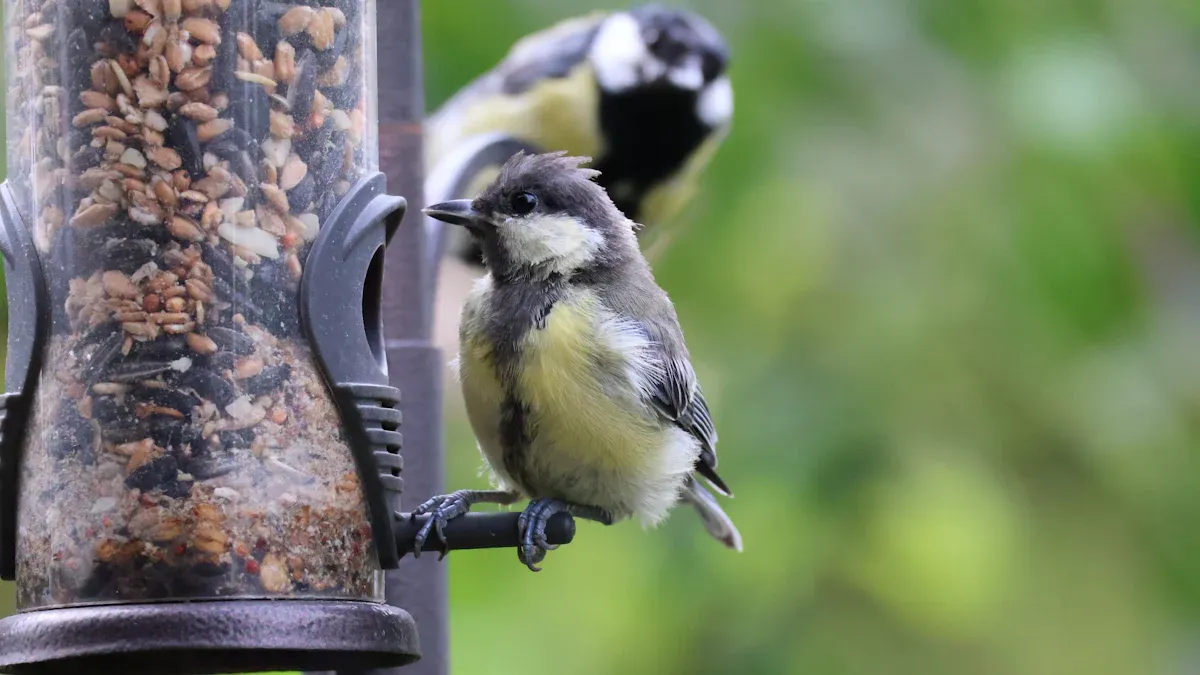
Have you ever wondered what makes dried mealworms such a hit with wild birds? These little power-packed snacks are loaded with protein, fat, and fiber, giving birds the energy they need to thrive. For example, dried mealworms contain about 52.8% protein, 24.7% fat, and 9% fiber—perfect for birds during nesting, molting, or cold winters. Plus, they’re super easy to store and use. Whether you’re feeding robins, bluebirds, or wrens, dried mealworms for feeding birds are a convenient way to attract a variety of feathered friends to your yard.
Key Takeaways
- Dried mealworms are healthy snacks for wild birds. They are full of protein, fat, and fiber. These give birds energy, especially in nesting season or cold weather.
- Dried mealworms are easy to use and save money. They last a long time, don’t need a fridge, and are simple to store. This makes feeding birds stress-free.
- You can attract many bird types with dried mealworms. Mix them with seeds or fruits for a balanced meal. This helps support local birds.
What Makes Dried Mealworms for Feeding Birds So Nutritious?

Nutritional Benefits of Dried Mealworms
When I first started feeding wild birds, I was amazed at how much nutrition dried mealworms pack into such a small snack. They’re like a superfood for birds! Let me break it down for you. Here’s a quick look at the nutrients they offer:
| Nutrient | Value |
|---|---|
| Crude Protein | 52.8% |
| Crude Fat | 24.7% |
| Calcium | 0.05% |
| Phosphorus | 1.03% |
| Sodium | 0.097% |
| Manganese (ppm) | 23 |
| Zinc (ppm) | 144 |
That high protein content is essential for birds, especially during breeding season or when they’re raising their young. The fat provides quick energy, which is crucial during migration or cold weather. I’ve noticed that birds seem more active and energetic after enjoying a mealworm snack. It’s like giving them a little boost to tackle their day.
Why Birds Are Naturally Attracted to Mealworms
Ever wondered why birds flock to mealworms? It’s all about instinct. In the wild, insects are a primary food source for many birds, and mealworms are a perfect substitute. They’re rich in protein and fat, which are vital for survival during nesting, egg-laying, and even harsh winters. I’ve seen bluebirds, robins, and chickadees eagerly snatch up mealworms, especially when natural food sources are scarce.
Mealworms also help adult birds feed their young. They’re soft, easy to digest, and packed with nutrients. It’s no surprise that approximately 96% of North American terrestrial birds rely on insects like mealworms at some point in their lives. Whether it’s a wren or a warbler, dried mealworms for feeding birds are a hit across species.
Dried Mealworms vs. Live Mealworms: Why Choose Dried?
Key Advantages of Dried Mealworms
When I first started feeding birds, I wasn’t sure whether to go with live or dried mealworms. After trying both, I quickly realized dried mealworms are the way to go. They’re so much easier to handle! Unlike live mealworms, which wiggle around and require constant care, dried mealworms are hassle-free. You don’t need to refrigerate them or worry about feeding them. Just open the bag, and you’re good to go.
Another big plus? They’re more economical. A single bag of dried mealworms lasts much longer than live ones. And let’s not forget storage. Dried mealworms have a long shelf life, so you can stock up without worrying about them spoiling. I’ve found this especially helpful during winter when natural food sources are scarce. It’s comforting to know I always have a reliable food option for my feathered visitors.
Addressing Misconceptions About Dried Mealworms
I’ve heard some myths about dried mealworms that might make people hesitate to use them. One common claim is that they cause dehydration in birds. That’s simply not true. Birds can rehydrate internally, and I’ve never seen any issues with dehydration in the birds I feed. In fact, soaking dried mealworms in water before offering them can provide an extra hydration boost, especially in the summer.
Another misconception is that dried mealworms are too fatty and could make birds obese. But here’s the thing—fat is essential for birds, especially during migration or cold weather. It gives them the energy they need to survive. Some people also worry about stomach compaction, but experts have debunked this. Birds have been eating insects with hard parts for millions of years without any problems.
| Myth | Clarification |
|---|---|
| Dried mealworms cause dehydration in birds | Birds can rehydrate internally and do not become dehydrated from eating dried mealworms. |
| Dried mealworms lead to obesity in birds | While they are high in fat, fat is essential for birds, especially during migration. |
| Dried mealworms cause stomach compaction | This claim is false; dried mealworms do not cause constipation or dehydration in birds. |
If you’ve been on the fence about using dried mealworms for feeding birds, I hope this clears up any doubts. They’re a safe, nutritious, and convenient option that birds absolutely love.
Practical Benefits of Dried Mealworms for Feeding Birds
Long Shelf Life and Easy Storage
One of the things I love most about dried mealworms is how easy they are to store. Unlike live mealworms, which need constant care, dried ones can sit on your shelf for months without any fuss. I usually keep mine in an airtight container in a cool, dry spot. This prevents moisture from sneaking in and keeps them fresh for longer. If you want to go the extra mile, you can store them in the refrigerator at around 40-50°F. This helps maintain their quality and ensures they’re ready whenever your feathered friends come calling.
Another tip? Make sure the storage area has good ventilation to avoid condensation. I’ve even used a paper towel to control moisture when needed. It’s such a simple solution, and it works like a charm!
Convenience in Bird Feeding
Feeding birds with dried mealworms couldn’t be easier. There’s no need to worry about feeding or refrigerating them like you would with live mealworms. Just grab a handful and toss them into a feeder. I’ve found that flat platform feeders or trays work best because they give birds easy access. Some feeders even come with drainage trays to keep the mealworms dry, which is especially handy during rainy days.
What’s more, dried mealworms are packed with protein, essential fatty acids, and minerals. They’re a nutritious option that requires zero maintenance. Plus, they’re less expensive than live mealworms, making them a budget-friendly choice for bird lovers like me.
Attracting a Variety of Bird Species
If you’re looking to attract a diverse group of birds to your yard, dried mealworms are the way to go. I’ve seen bluebirds, robins, and even chickadees flock to my feeders when I put out mealworms. It’s fascinating to watch how different species interact and enjoy the treat. Bluebirds, in particular, seem to love them. They’re a great way to support local wildlife and bring more life to your backyard.
Adding dried mealworms to your feeding routine is like sending out an open invitation to the bird community. You’ll be amazed at the variety of feathered visitors that show up!
How to Feed Wild Birds with Dried Mealworms

Introducing Dried Mealworms to Your Feeding Routine
When I first started using dried mealworms, I wasn’t sure how to get the birds interested. Over time, I discovered a few tricks that worked wonders. First, I chose a flat platform feeder with drainage holes. It made the mealworms easy to spot and kept them dry. I placed the feeder near some bushes, where birds felt safe while feeding.
I also started slow. At first, I mixed a small handful of dried mealworms with seeds to see how the birds reacted. They loved it! Gradually, I increased the amount of mealworms. To keep things fresh, I refilled the feeder regularly and cleaned it often. This helped prevent mold and kept the birds healthy. If you’re just starting out, these steps can make all the difference.
Tips for Using Dried Mealworms in Feeders
Using the right feeder is key. I’ve found that feeders with tall sides work best because they keep the mealworms from blowing away. A roof or baffle is also helpful, especially on rainy days. Drainage holes are a must to avoid water pooling. If you’re worried about pests, look for feeders designed to deter rodents.
Sometimes, birds take a little convincing. Soaking dried mealworms in lukewarm water makes them softer and more appealing. You can also sprinkle a few on the ground for ground-feeding birds like robins. If you’ve got live mealworms, try offering those briefly to attract birds before switching back to dried ones.
Combining Dried Mealworms with Other Bird Foods
One of my favorite tricks is mixing dried mealworms with other foods. Sunflower hearts, suet balls, and fresh fruit pair beautifully with mealworms. This combination creates a balanced meal that supports birds’ energy and overall health. Plus, it attracts a wider variety of species. I’ve seen everything from bluebirds to chickadees enjoying the mix.
If you’re looking to cater to both insect-eating and seed-eating birds, try combining mealworms with black sunflower seeds or peanuts. It’s a simple way to make your feeder a hotspot for all kinds of feathered friends. Trust me, the birds will thank you!
Dried mealworms are a game-changer for bird enthusiasts like me. They’re packed with protein, essential fats, and minerals, making them a nutritious treat for wild birds. Plus, they’re so easy to store and use. I’ve seen firsthand how they attract a variety of species, from robins to chickadees. If you’re looking to enhance your bird-watching experience, give dried mealworms a try. They’re a simple way to support local wildlife while enjoying the beauty of nature in your own backyard.
As Kenn and Kimberly Kaufman suggest, soaking dried mealworms in lukewarm water can make them even more appealing to birds. It’s a small step that can make a big difference in attracting feathered visitors.
FAQ
How often should I feed dried mealworms to wild birds?
I recommend offering dried mealworms a few times a week. Birds love variety, so mix them with seeds or fruits for a balanced diet.
Can I feed dried mealworms to birds year-round?
Absolutely! Dried mealworms are perfect all year. They provide protein and fat during winter and hydration when soaked in water during summer.
Do all bird species eat dried mealworms?
Not all birds eat them, but many do! Bluebirds, robins, wrens, and chickadees love them. Try adding them to your feeder and see who visits! 🐦


